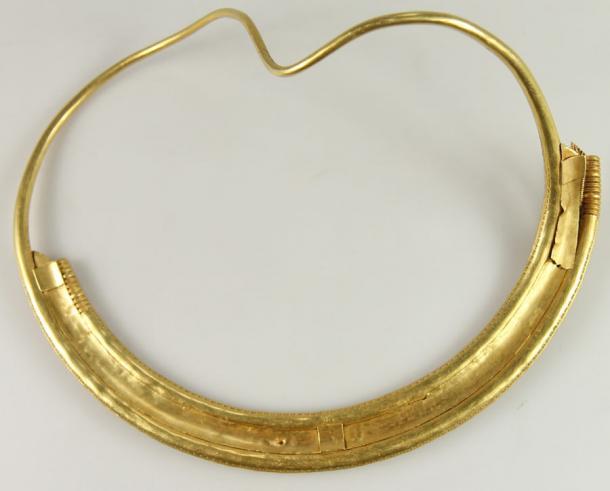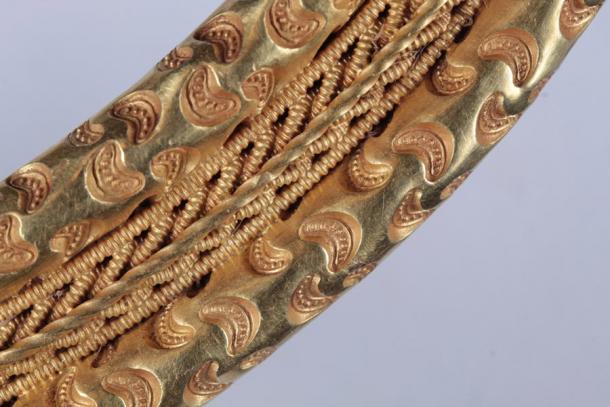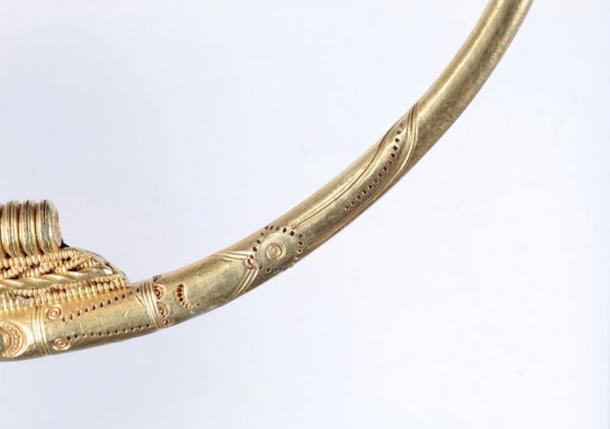In October 2021, amateur metal detectorist Dan Christensen unearthed an extraordinary artifact—a gold neck ring of exceptional craftsmanship and historical significance. Discovered in a field near Esbjerg on the Jutland Peninsula in mainland Denmark, this 1,700-year-old treasure has captivated experts and enthusiasts alike. Described by the Southwest Jutland Museum as a “masterpiece of almost divine quality,” the neck ring is a remarkable testament to the artistry of the Germanic Iron Age.
A Magnificently Crafted and Unusual Gold Neck Ring
The gold neck ring measures an impressive 93 centimeters (36 inches) in length and is fashioned from a rod-shaped piece of gold. Its circular cross-section is narrower in the center, gradually thickening towards the ends. At its widest point, the ring spans 21 centimeters (8 inches).

The intricate design of the neck ring highlights its superb craftsmanship. The rod was meticulously bent into a ring shape, with approximately one-third of the ends overlapping. This overlapping portion is adorned with a crescent-shaped pattern. The ends of the ring feature a series of flat gold beads, while the area tapering towards the center showcases a neat pattern of furrows and small pistons forming an elongated design. A thin plate, soldered to the back between the overlapping parts, serves as a base for a delicate frieze of six thin ribbed gold wires. Four of these wires are braided together, and a seventh spirally twisted gold wire is placed above.
The detailed and elegant design of this neck ring has earned it recognition as one of the finest examples of its kind, with only ten similar necklaces featuring stamped patterns discovered in Denmark to date. Its exceptional beauty and the soldered plate with braided gold wire make it particularly unusual.
Was the “Almost Divine” Necklace a Divine Offering?

Archaeologists believe that the neck ring was intentionally hidden by its owner rather than being a votive offering to the gods. In the Iron Age, votive offerings were typically made in wetlands, and the proximity of a wetland near the discovery site suggests that if the ring had been intended as an offering, it would likely have been placed there instead.
Claus Feveile, curator at the Ribe Viking Museum, notes that the pristine condition of the gold neck ring implies it was never moved after being buried. Pure gold is highly malleable, and the ring’s preserved shape suggests it remained undisturbed in its original location. “The gold is so pure and therefore also so soft that the ring would not have retained its shape as nicely if it had been moved around with tools,” Feveile explained. “The excavation indicates that we have found the very hole in which the neck ring was hidden.”
Why Was Such a Valuable Treasure Hidden?

If the neck ring was not a divine offering, what was its purpose? The period between 536 and 540 AD saw a series of natural disasters, likely volcanic eruptions, which triggered a brief climatic cooling known as the Late Antique Little Ice Age. This period led to increased sacrificial offerings in an attempt to appease the gods and mitigate the effects of the climate change. Such offerings were typically buried in wetlands and left unretrieved.
In contrast, the Esbjerg neck ring appears to have been buried deliberately, possibly under the owner’s house. This suggests that it might have been hidden to protect it from potential looters or as a precaution in times of threat. Alternatively, it could have been intended for retrieval later if its value needed to be realized. Unfortunately, the owner never returned to reclaim it, perhaps due to unforeseen disaster.
Ultimately, the ring was rediscovered by Dan Christensen, centuries after it was hidden. Perhaps in a twist of fate, the gods are having the last laugh, with the neck ring now serving as a stunning reminder of its era.
Conclusion
The discovery of the 1,700-year-old gold neck ring in Denmark offers a glimpse into the sophisticated craftsmanship and complex practices of the Germanic Iron Age. Its detailed design and remarkable preservation underscore its significance as a masterpiece of ancient art. While its exact purpose remains a mystery, the neck ring’s story adds a fascinating chapter to our understanding of historical artifacts and their enigmatic past.
